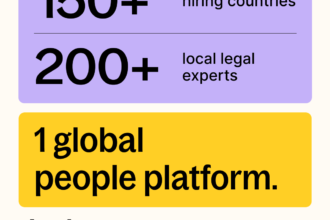As businesses expand internationally, hiring and managing talent across different countries presents both opportunities and challenges. Companies must navigate cultural differences, local labor laws, payroll compliance, and employee expectations to build a successful global workforce.
In this blog, we’ll explore key insights on global hiring trends, challenges in talent management, and best practices for companies looking to scale their teams internationally.
Key Trends in Global Hiring
1. Rise of Remote and Hybrid Work
The shift towards remote work has enabled companies to hire top talent worldwide without requiring employees to relocate. This trend has made global hiring more flexible and cost-effective.
2. Demand for Skilled International Talent
Companies are increasingly looking beyond local talent pools to fill skill gaps, especially in industries such as technology, finance, and engineering. Hiring globally provides access to a diverse and highly skilled workforce.
3. Employer of Record (EOR) Services for Seamless Hiring
Many businesses now rely on EOR services to manage legal employment contracts, payroll, and compliance when hiring in new markets. This approach helps avoid setting up costly legal entities in multiple countries.
4. Focus on Diversity, Equity, and Inclusion (DEI)
Global hiring allows companies to build more diverse teams, fostering innovation and better decision-making. Employers are prioritizing inclusive hiring practices to attract talent from different backgrounds and cultures.
Challenges in Global Talent Management
1. Navigating Local Labor Laws
Each country has unique employment regulations, including work hours, termination policies, minimum wages, and employee benefits. Employers must ensure full compliance with these laws.
2. Managing Multi-Currency Payroll
Paying employees in their local currency while handling exchange rate fluctuations and tax deductions can be complex. Global payroll solutions help streamline payments and tax compliance.
3. Cultural and Communication Barriers
Different cultural expectations around work-life balance, management styles, and communication can impact team collaboration. Companies must invest in cultural training and localized HR policies.
4. Retaining Global Talent
Employee expectations vary by region. Providing competitive benefits, career growth opportunities, and strong company culture is key to retaining top international talent.
Best Practices for Global Hiring & Talent Management
✔ Use an EOR or Global Payroll Provider to simplify compliance, payroll, and HR management.
✔ Develop a Strong Onboarding Process tailored to different cultural and legal environments.
✔ Implement Digital HR Tools for seamless talent management across different time zones.
✔ Prioritize Employee Well-being by offering region-specific benefits and work flexibility.
✔ Build a Diverse and Inclusive Workforce through intentional hiring strategies.
Conclusion
Global hiring is a powerful strategy for businesses seeking growth, innovation, and access to top talent worldwide. By leveraging EOR services, payroll solutions, and strong HR policies, companies can overcome hiring challenges and effectively manage a global workforce.






